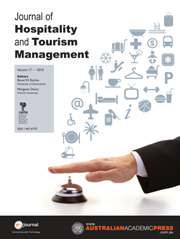Crossref Citations
This article has been cited by the following publications. This list is generated based on data provided by
Crossref.
Guo, Yuanyuan
Denizci Guillet, Basak
Kucukusta, Deniz
and
Law, Rob
2016.
Segmenting Spa Customers Based on Rate Fences Using Conjoint and Cluster Analyses.
Asia Pacific Journal of Tourism Research,
Vol. 21,
Issue. 2,
p.
118.
Jiang, Nan
and
Poorani, Ali
2016.
Medical Tourism and Wellness.
p.
369.
Chang, Wen-Jung
and
Katrichis, Jerome M.
2016.
A literature review of tourism management (1990–2013): a content analysis perspective.
Current Issues in Tourism,
Vol. 19,
Issue. 8,
p.
791.
Dryglas, Diana
and
Różycki, Paweł
2017.
Profile of tourists visiting European spa resorts: a case study of Poland.
Journal of Policy Research in Tourism, Leisure and Events,
Vol. 9,
Issue. 3,
p.
298.
Derco, Jan
and
Pavlisinova, Dominika
2017.
Financial position of medical spas – The case of Slovakia.
Tourism Economics,
Vol. 23,
Issue. 4,
p.
867.
Hudson, Simon
Thal, Karen
Cárdenas, David
and
Meng, Fang
2017.
Wellness tourism: stress alleviation or indulging healthful habits?.
International Journal of Culture, Tourism and Hospitality Research,
Vol. 11,
Issue. 1,
p.
35.
Dryglas, Diana
and
Salamaga, Marcin
2017.
Applying destination attribute segmentation to health tourists: A case study of Polish spa resorts.
Journal of Travel & Tourism Marketing,
Vol. 34,
Issue. 4,
p.
503.
Zhang, Linghan
Wu, Lingling
and
Zhang, Junyi
2017.
Life-Oriented Behavioral Research for Urban Policy.
p.
205.
Koščak, Marko
Mišković, Ivana
Romanov, Romana
and
Holodkov, Vladimir
2018.
Education for work in wellness tourism: Case study.
TIMS. Acta,
Vol. 12,
Issue. 2,
p.
89.
Dryglas, Diana
and
Salamaga, Marcin
2018.
Segmentation by push motives in health tourism destinations: A case study of Polish spa resorts.
Journal of Destination Marketing & Management,
Vol. 9,
Issue. ,
p.
234.
Hartwell, Heather
Fyall, Alan
Willis, Cheryl
Page, Stephen
Ladkin, Adele
and
Hemingway, Ann
2018.
Progress in tourism and destination wellbeing research.
Current Issues in Tourism,
Vol. 21,
Issue. 16,
p.
1830.
CEYLAN, Uğur
2019.
TERMAL KONAKLAMA İŞLETMELERİNİN TERCİH EDİLMELERİNDE ETKİLİ OLAN FAKTÖRLER: KÜTAHYA İLİNDE BİR ARAŞTIRMA.
Trakya Üniversitesi Sosyal Bilimler Dergisi,
Vol. 21,
Issue. 0,
p.
181.
Liu, Xiaoming
Fu, Yi
and
Li, Jun
2019.
The effect of on-site experience and place attachment on loyalty: Evidence from Chinese tourists in a hot-spring resort.
International Journal of Hospitality & Tourism Administration,
Vol. 20,
Issue. 1,
p.
75.
Derco, Ján
Romaniuk, Piotr
and
Cehlár, Michal
2020.
Economic Impact of the Health Insurance System on Slovak Medical Spas and Mineral Spring Spas.
Sustainability,
Vol. 12,
Issue. 8,
p.
3384.
Mijajlović, Miroslav
Puška, Adis
Stević, Željko
Marinković, Dragan
Doljanica, Dragan
Jovanović, Saša Virijević
Stojanović, Ilija
and
Beširović, Jasminka
2020.
Determining the Competitiveness of Spa-Centers in Order to Achieve Sustainability Using a Fuzzy Multi-Criteria Decision-Making Model.
Sustainability,
Vol. 12,
Issue. 20,
p.
8584.
Cai, Gangwei
Hong, Yan
Xu, Lei
Gao, Weijun
Wang, Ka
and
Chi, Xiaoting
2020.
An Evaluation of Green Ryokans through a Tourism Accommodation Survey and Customer-Satisfaction-Related CASBEE–IPA after COVID-19 Pandemic.
Sustainability,
Vol. 13,
Issue. 1,
p.
145.
Sonuç, Nil
2020.
Industrial and Managerial Solutions for Tourism Enterprises.
p.
110.
Brandão, Filipa
Liberato, Dália
Teixeira, Ana Sofia
and
Liberato, Pedro
2021.
Motives for Thermal Tourism: An Application to North and Central Portugal.
Sustainability,
Vol. 13,
Issue. 22,
p.
12688.
Park, Hyekyung
Lee, Minwoo
and
Back, Ki-Joon
2021.
Exploring the roles of hotel wellness attributes in customer satisfaction and dissatisfaction: application of Kano model through mixed methods.
International Journal of Contemporary Hospitality Management,
Vol. 33,
Issue. 1,
p.
263.
Büyüközkan, Gülçin
Mukul, Esin
and
Kongar, Elif
2021.
Health tourism strategy selection via SWOT analysis and integrated hesitant fuzzy linguistic AHP-MABAC approach.
Socio-Economic Planning Sciences,
Vol. 74,
Issue. ,
p.
100929.




